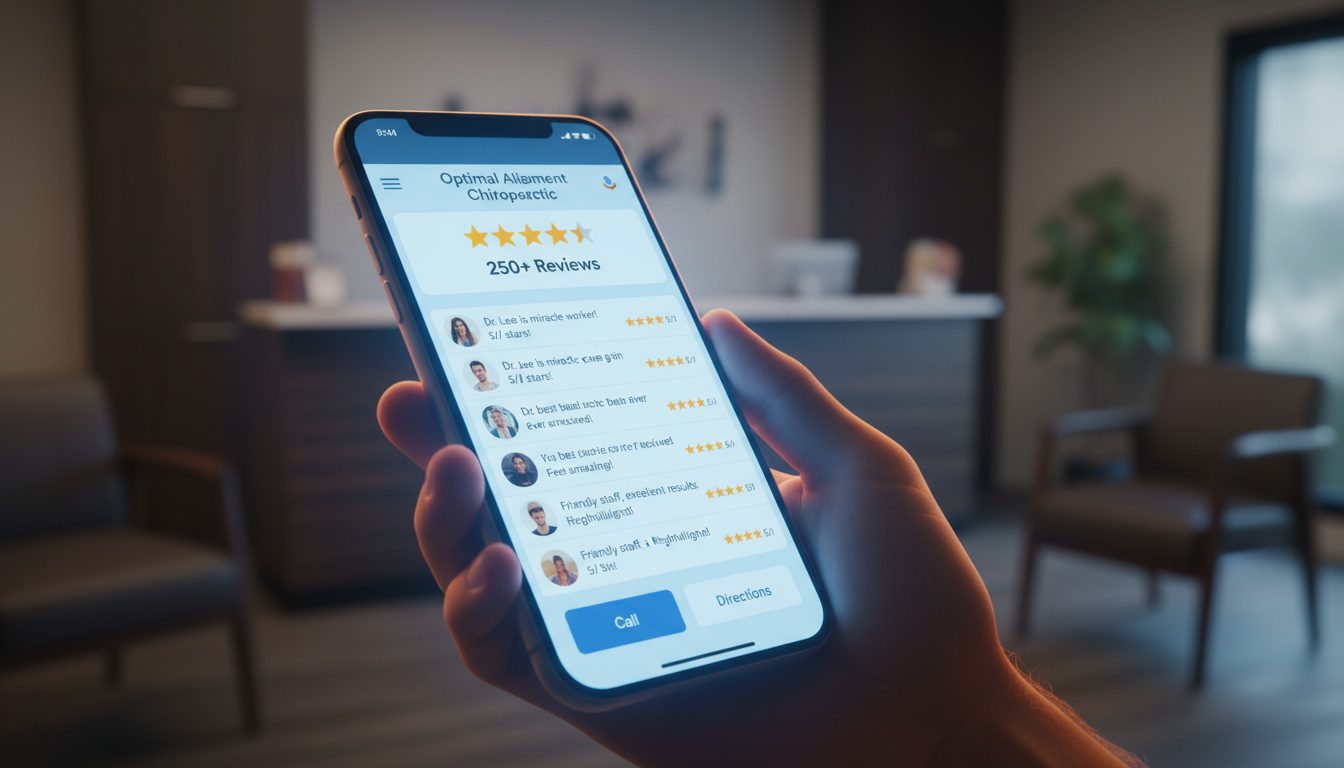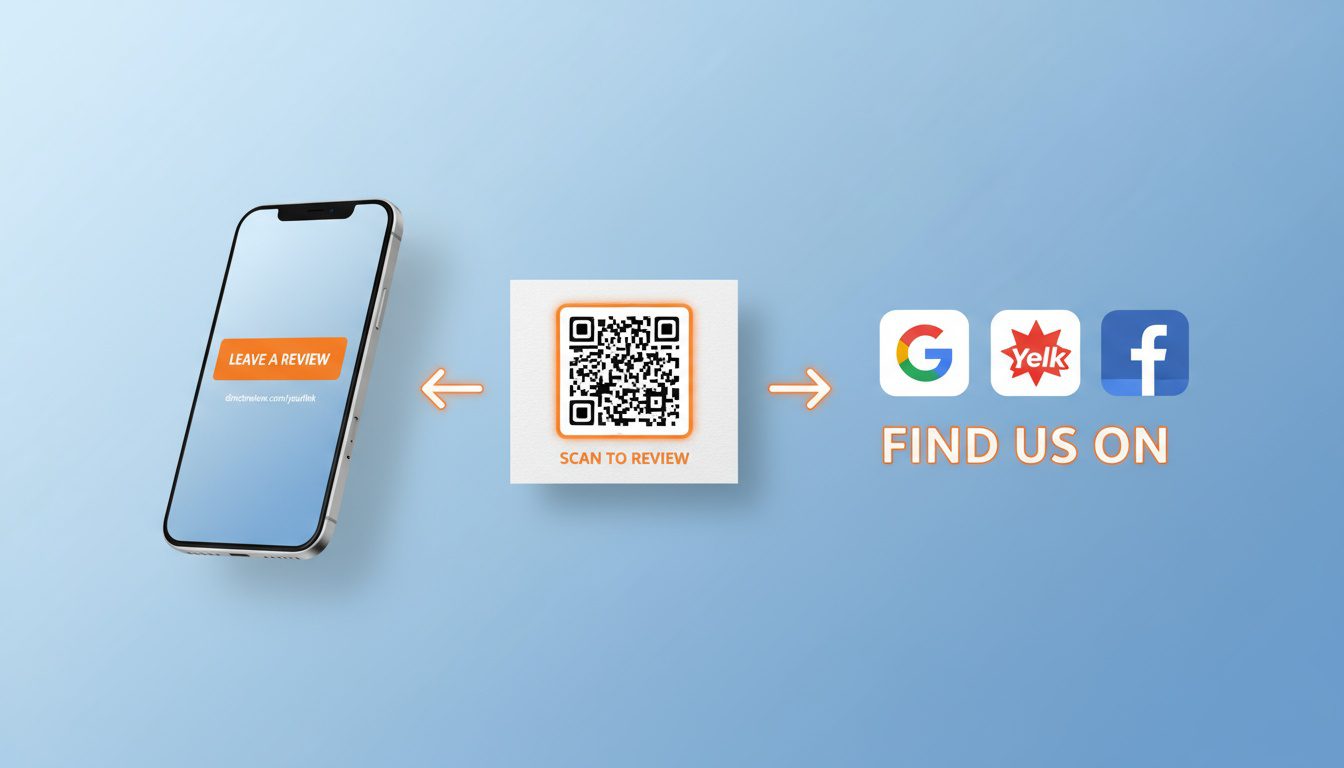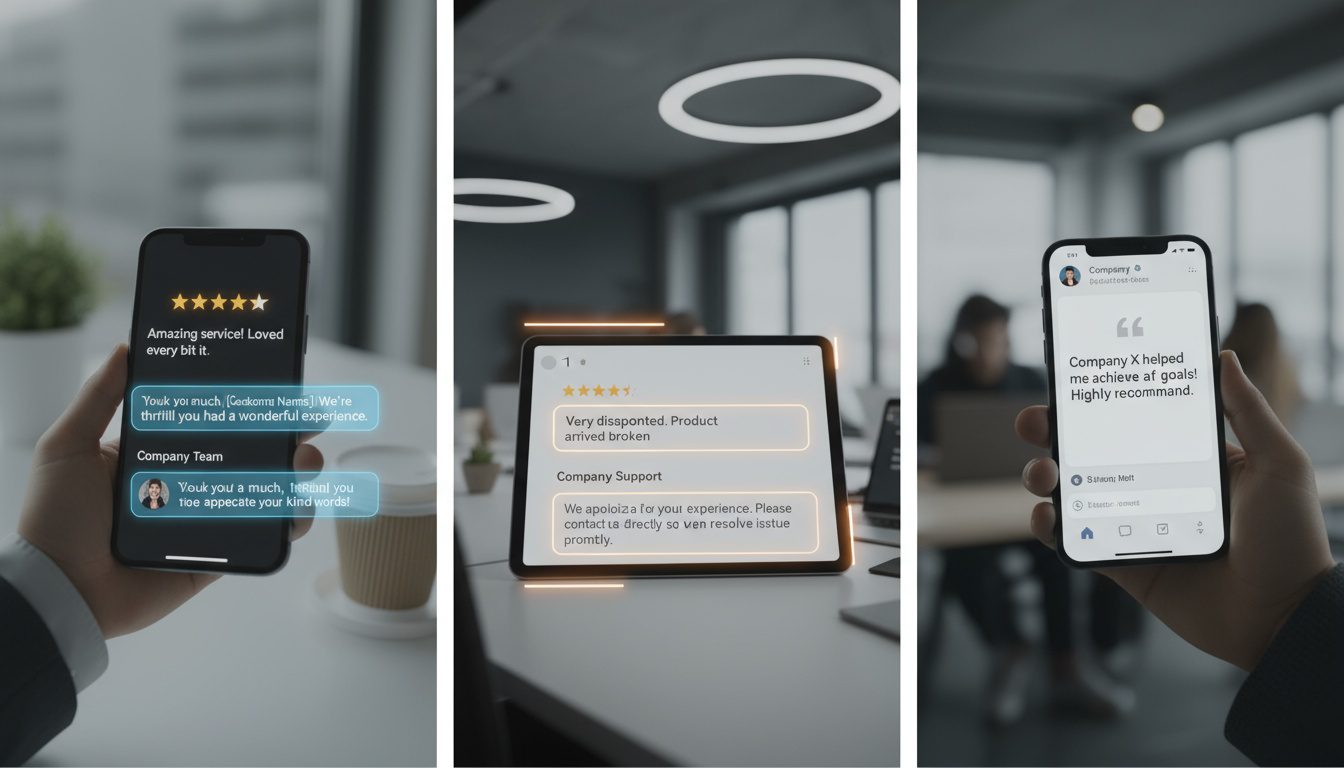
How Do I Get More Patient Reviews for My Chiropractic Practice? (Step-by-Step System)
![]() by Gerek Allen ~ Last Updated: November 3rd, 2025 ~ 8 Min Read
by Gerek Allen ~ Last Updated: November 3rd, 2025 ~ 8 Min Read
![]() by Gerek Allen
by Gerek Allen
~ Last Updated: November 3rd, 2025 ~
~ 8 Min Read ~
The short answer: Build a systematic approach that asks at the right moment, makes leaving reviews effortless, and follows up automatically. Start by training your team to request reviews immediately after breakthrough moments when patients express relief or satisfaction. Make it simple with direct links and QR codes. Then set up automated follow-up via text or email 24-48 hours after appointments.
Here's the reality most chiropractors face: you're delivering excellent care that transforms patients' lives, but those success stories aren't showing up online where potential patients are looking. Your happy patients walk out feeling great and completely forget to share their positive experience, while dissatisfied patients are far more likely to leave reviews without any prompting.
93% of consumers report that online reviews influence their purchasing decisions, and 87% check Google Reviews specifically when evaluating local businesses. Your online reputation is now your most powerful marketing tool, whether you're actively managing it or not.
The good news? You don't need a marketing degree or expensive software to fix this. You need a simple, repeatable system that your entire team can follow. In this guide, I'll walk you through exactly how to build that system, from the perfect moment to ask for a review to the automation tools that make it sustainable long-term.
Let me show you how to turn your happy patients into your best marketing team.
Why Patient Reviews Actually Matter for Your Practice

Let me paint you a picture of what's happening right now in your community.
Someone wakes up with excruciating neck pain that's been getting worse for weeks. They can't turn their head without wincing. Their first move isn't to ask friends for recommendations anymore - it's to pull out their phone and search "chiropractor near me."
Your practice shows up in the results. So do four other chiropractors within three miles.
Here's what happens next: they see your star rating and recent reviews before they even click on your website. That snapshot of social proof makes an instant decision for them. Five stars with 89 recent reviews? They're calling you. Three stars with the last review from eight months ago? They're scrolling past.
Your online reputation is working 24/7 as your most powerful marketing tool. It's answering the question every potential patient is asking: "Can I trust this person with my health?"
Research shows that people read online reviews for healthcare providers even more carefully than for restaurants or hotels. They're not just looking for a good experience - they're looking for reassurance that you can actually help them with their specific problem. They want to see stories from people like them who came in with chronic pain and left feeling great.
The challenge isn't patient satisfaction. You're already providing excellent care. The problem is that happy patients rarely think to leave reviews on their own, while dissatisfied patients (even unreasonably upset ones) are highly motivated to share their negative experience.
You need a system that flips this dynamic and makes it just as easy for satisfied patients to share their stories.
The Perfect Moment to Ask for a Review

Timing is everything when asking for reviews.
Ask too early, and the patient hasn't experienced enough results to feel enthusiastic. Ask too late, and the positive emotions have faded and they've moved on with their life. Ask when they're rushed or frustrated about billing, and you'll get a hard no or worse - a negative review.
The absolute best time to ask is immediately after a breakthrough moment. This is when a patient:
- Mentions they're now pain-free for the first time in months
- Expresses genuine gratitude for how much better they feel
- Comments that they can finally sleep through the night or play with their kids again
- Hits a major milestone in their treatment plan
Their positive emotions are at their peak. The relief they're experiencing is fresh and real. This is when they're most likely to enthusiastically share their story with others.
For example, let's say you just adjusted someone who came in barely able to walk due to sciatica. After the adjustment, they stand up and realize the shooting pain is gone. They look at you with genuine amazement and say, "Oh my god, I can't believe how much better that feels already."
That's your moment right there.
A simple response like, "I'm so glad we could help. You know, stories like yours really help other people in Huntington Beach who are dealing with similar issues find the care they need. Would you mind sharing your experience online?" feels natural and purposeful.
You're not asking for a favor. You're giving them an opportunity to help someone else who's suffering right now the same way they were suffering last week.
Here's what doesn't work: generic automated emails sent to everyone three days after their first appointment, regardless of their progress or satisfaction level. That's impersonal and easy to ignore.
The personal touch matters. When your front desk staff or you as the chiropractor directly ask a patient face-to-face, the success rate is dramatically higher than any automated system alone.
Make Leaving Reviews Ridiculously Easy

Here's a brutal truth about human behavior: people will choose the path of least resistance every single time.
If leaving a review requires them to remember your practice name, search for you on Google, figure out which listing is actually yours, navigate to the review section, and then write something - you've already lost 80% of people who had good intentions.
You need to eliminate every possible friction point.
Provide Direct Links
Create shortened URLs that take patients straight to your review page on each platform. Not to your homepage. Not to your general business profile. Directly to the "Write a Review" form.
For Google, this means creating a direct review link through your Google Business Profile. For Yelp and Facebook, same thing - find the direct review URL and shorten it to something memorable.
Print these links on:
- Business cards you hand out at the end of successful visits
- Appointment reminder cards
- Thank-you postcards you mail to long-term patients
- Text messages you send as follow-ups
A direct link eliminates 5-6 steps and takes them exactly where they need to go in one click. This small convenience makes a massive difference in completion rates.
Use QR Codes Everywhere
Generate QR codes for each of your preferred review platforms. These codes should link to the exact same direct review URLs mentioned above.
Place QR codes strategically:
- On the checkout counter where patients are already on their phones
- In the waiting room on table tents or wall posters
- On the back of your business cards
- On printed educational materials you give patients
The beauty of QR codes is that patients can scan them instantly while they're standing right there in your office, often while they're still feeling that post-adjustment relief. The moment they sit back down in their car, they're already writing their review.
This is incredibly effective because you're capturing them at the peak emotional moment rather than hoping they remember to do it later.
Offer Multiple Platform Options
Not everyone uses Google as their primary platform. Some patients are active Facebook users but rarely interact with Google Reviews. Others trust Yelp or healthcare-specific sites like Healthgrades.
Give them a choice. Present 2-3 platform options and let them pick whichever one they're most comfortable with.
You might say, "We'd love to hear about your experience. Are you more of a Google person or Facebook person?" Then send them the appropriate link.
This empowers them and significantly increases the likelihood they'll actually follow through. It also helps you build a robust review profile across multiple platforms, which strengthens your overall online presence and reaches different audiences.
Build an Automated Follow-Up System

Let me be blunt: asking once in person is not enough. Life gets busy, patients get distracted, and good intentions get forgotten the moment they walk out your door.
You need a systematic follow-up process that gently reminds them without being annoying.
Send Thank-You Emails 24-48 Hours Later
The day or two after an appointment, send a personalized thank-you email that serves two purposes: it shows you value their business, and it includes a direct review link.
Keep it short and genuine:
"Hi [Patient Name], thanks so much for trusting us with your care yesterday. We hope you're continuing to feel the improvement from your adjustment. If you have a moment, we'd be grateful if you'd share your experience with others who might be looking for similar help. [Direct Review Link]"
This message keeps the positive experience top of mind. It demonstrates that you're still thinking about their care even after they've left the office, which reinforces the relationship you've built.
Patients who feel genuinely cared for are far more likely to reciprocate with a review.
Text Message Reminders for Patients Who Opt In
If your patients have consented to text communication, a brief SMS with a review link can be highly effective.
Text messages have 90%+ open rates compared to 20-30% for emails. They're quick, direct, and feel more personal than email.
Keep it conversational and short:
"Hi [Patient Name]! Thanks for coming in yesterday. If you've got 2 minutes, we'd love to hear about your experience: [Direct Review Link]. - The team at [Your Practice Name]"
The key is brevity and convenience. They can tap the link and leave a review while waiting in line at the grocery store.
Just be sure to respect communication preferences and only text patients who have explicitly opted in. Nothing kills goodwill faster than unexpected marketing texts.
Personal Phone Calls for Long-Term or Transformational Patients
For patients you've treated over months or years, or those who have experienced truly life-changing results, a personal phone call from you as the chiropractor can be incredibly impactful.
This isn't a sales call. It's a genuine check-in on their progress.
"Hey [Patient Name], I wanted to personally follow up and see how you're feeling after our work together. I know you came in unable to work due to back pain, and seeing you back on the job has been amazing."
If they express genuine gratitude and satisfaction during the call, that's your natural opening:
"I'm so glad we could help. You know, your story could really inspire someone else who's struggling with similar issues right now. Would you be willing to share your experience in a quick online review?"
This level of personal attention is rare and highly valued. It reinforces that you're not just a doctor who sees patients - you're someone who genuinely cares about their well-being beyond the office visit.
This approach is perfect for securing detailed, heartfelt testimonials about overcoming problems that other doctors couldn't solve.
You can learn more about building patient loyalty through systematic follow-up in our guide on chiropractic referral programs.
How to Incentivize Reviews Without Breaking the Rules

Here's where things get tricky, so pay close attention.
You cannot pay for positive reviews. Google, Yelp, Facebook - all the major platforms explicitly prohibit this, and getting caught can result in your entire review profile being removed or flagged.
But you can ethically reward the act of leaving feedback without conditioning the reward on the rating itself.
Here's the breakdown:
Ethical Incentives:
- Entering all reviewers (regardless of rating) into a monthly drawing for a wellness prize like a massage gift certificate
- Donating $10 to a local charity for every review received during a specific month
- Providing a small, unannounced thank-you gift (like a branded water bottle) after a review is posted
- Offering to write a review for a patient's business in return for them reviewing yours
Problematic Incentives That Will Get You in Trouble:
- Paying cash directly for a positive review
- Offering discounts on future services only for 5-star reviews
- Requiring patients to show you their positive review before receiving a gift
- Pressuring a patient to change or remove a negative review in exchange for anything
The key difference is simple: you reward participation, not the rating.
You can say, "We're donating $10 to the local food bank for every review we receive this month, whether it's positive or constructive feedback. We just want to hear from you."
You cannot say, "Leave us a 5-star review and get 20% off your next visit."
See the difference?
When patients see you supporting local causes or running community-focused initiatives, it strengthens their loyalty and connection to your practice. They feel like they're part of something bigger than just a transaction.
The goal is to foster a sense of community and mutual appreciation, not to buy positive reviews.
Respond to Every Single Review (Yes, Every Single One)

Most chiropractors treat reviews as a one-way street. Patients leave them, and that's where the interaction ends.
That's a massive missed opportunity.
Engaging with every review - both positive and negative - demonstrates that you're an attentive, caring provider who values feedback. It also shows potential patients reading your reviews that you're actively involved and committed to excellent service.
Thank Every Positive Reviewer
Always take a moment to thank patients for their kind words. Even a simple response matters.
Don't just copy and paste "Thanks!" to everyone. Personalize it:
"Thank you so much, Jennifer. We're so glad we could help with your shoulder pain and that you're back to playing tennis. We appreciate you taking the time to share your experience."
This validates their effort and makes them feel genuinely appreciated. It also shows future readers that you pay attention to individual patients, not just numbers.
Responding to positive reviews actually encourages more people to leave reviews. When patients see that you engage with feedback, they feel like their voice matters and are more likely to participate.
Address Negative Reviews Like a Pro
Let's be real: you will eventually get a negative review. Maybe the patient had unrealistic expectations. Maybe they had a bad day and took it out on your practice. Maybe there was a legitimate service issue.
How you respond matters more than the review itself.
Respond within 24-48 hours with a calm, professional tone. Never get defensive. Never argue.
Here's the formula:
- Acknowledge their concern without admitting fault
- Apologize for their experience not meeting expectations
- Invite them to discuss the matter privately to protect their privacy (and maintain HIPAA compliance)
Example response:
"We're sorry to hear about your experience, and we appreciate you taking the time to share your concerns. We take all feedback seriously and would like to understand more about what happened. Please call our office manager directly at [phone number] so we can address this with you personally."
This approach shows potential patients reading the review that you care about resolving issues and are willing to make things right. A well-handled negative review can actually build credibility.
For more in-depth strategies on managing your online reputation, check out our guide on chiropractic review management.
Turn Reviews Into Marketing Gold
Positive reviews are powerful testimonials that you should absolutely be using in your marketing.
With the patient's permission, share glowing reviews on:
- Your website testimonials page
- Social media posts (create attractive graphics with quotes)
- Email newsletters to current patients
- Printed materials in your waiting room
When you highlight stories of patients finding relief from migraines, avoiding surgery, or getting back to activities they love, you're showing potential patients exactly what's possible for them.
This social proof is more persuasive than anything you could say about yourself.
Train Your Entire Team on the Review System

You cannot be the only person in your practice asking for reviews. That's not scalable, and you'll miss too many opportunities when you're busy with patients or out of the office.
Everyone on your team - front desk, chiropractic assistants, office manager - needs to be aligned with your review acquisition strategy and comfortable executing it.
Explain Why This Actually Matters
Don't just tell your staff "we need more reviews" without context.
Help them understand how reviews directly impact the practice's growth and their job security. Explain that positive reviews are the #1 factor potential patients consider when choosing a chiropractor. More reviews = more new patients = more stable practice = better opportunities for everyone.
When your team sees the direct connection between their efforts and practice growth, they'll be far more motivated to participate consistently.
Show them the data: "We tracked it last month, and 8 out of 10 new patients mentioned they chose us because of our reviews. That's how powerful this is."
Your team should also understand that their super-friendly attitude and professionalism directly contribute to positive reviews. Every positive interaction they have with a patient is laying the groundwork for a future 5-star review.
Role Play Asking for Reviews
Asking for something - even a review - can feel awkward at first, especially for staff who aren't naturally outgoing.
Conduct role-playing exercises where team members practice different scenarios:
- Asking a first-time patient who just had their initial adjustment
- Following up with a long-term patient who just hit a major milestone
- Handling a situation where a patient seems rushed
- Responding when a patient says "I don't really do online reviews"
This practice builds confidence and helps everyone find a natural, comfortable way to make the request that fits their personality.
The goal is to make asking for reviews feel like a seamless, normal part of the checkout process - not an uncomfortable sales pitch.
Create a Clear, Documented Process
Develop a systematic process for when and how to ask for reviews, and document it so there's zero confusion.
For example:
"After a patient's third visit, if they express satisfaction or improvement, the chiropractor mentions the impact of reviews. At checkout, the front desk provides a business card with QR codes and says, 'Dr. [Name] mentioned you're doing great. If you have a moment, we'd love to hear about your experience. You can scan either of these codes to leave a quick review.'"
A consistent process ensures that no opportunities are missed and that patients aren't asked multiple times by different team members (which would be annoying).
Make this process part of your standard operating procedures and review it during team meetings. Track which team members are most successful and have them share their approach with others.
Use Technology to Scale Your Review System

Let's talk about working smarter, not harder.
Manual follow-up is great, but it doesn't scale as your practice grows. You need technology to automate the repetitive parts while keeping the personal touch where it matters.
Review Management Software
Platforms like Podium, Birdeye, and Swell are specifically designed to help local businesses manage their online reputation.
These tools can:
- Automatically send review requests via text or email after appointments
- Consolidate reviews from Google, Yelp, Facebook, and other sites into one dashboard
- Alert you immediately when new reviews are posted
- Provide templates for responding quickly
- Track your review volume and rating trends over time
The cost typically ranges from $300-500 per month, which might sound like a lot, but consider this: if automated review requests bring in just 2-3 additional new patients per month who wouldn't have found you otherwise, the software pays for itself many times over.
If budget is tight right now, you can start with manual follow-up using your existing patient management system and upgrade to dedicated review software once you're generating enough new patients to justify the investment.
Automated Email Campaigns Through Your Practice Management Software
Most modern chiropractic practice management systems (like Jane, SimplePractice, or ChiroTouch) have built-in email automation capabilities.
Set up triggered emails that automatically send 24-48 hours after an appointment. Customize the message to feel personal, include the patient's name, and provide a direct review link.
The beauty of automation is consistency. Every single patient gets the follow-up at the optimal time, regardless of how busy you are or whether you remember to manually send it.
You can also create segmented campaigns for different patient types:
- New patients after their third visit
- Patients completing a treatment plan
- Long-term maintenance patients after a milestone
Social Media Integration
Regularly share your positive reviews on your social media platforms. This serves multiple purposes:
- It showcases your success and builds credibility with your followers
- It subtly reminds your social media audience to share their own experiences
- It provides engaging content that's authentic and relatable
Create attractive graphics featuring powerful quotes from reviews (always with the patient's permission). Use your brand colors and make them visually appealing.
When current patients see you highlighting other patients' stories, they're reminded, "Oh yeah, I should leave a review too. They really helped me with my back pain."
This social proof compounds over time and becomes a powerful part of your overall marketing strategy.
For more ideas on leveraging social media effectively, see our article on chiropractic social media marketing.
Monitor, Analyze, and Continuously Improve
Your reviews aren't just testimonials - they're a valuable source of data that can help you improve your practice and marketing.
You need to regularly monitor and analyze this feedback to understand what's working and what needs adjustment.
Track Your Review Volume and Average Rating
Set up a simple spreadsheet or use your review management software to track:
- How many reviews you receive each month
- Your average star rating across platforms
- Which platforms are generating the most reviews
- Which team members are most successful at securing reviews
Set realistic goals and measure progress. If you're currently getting 2-3 reviews per month, set a goal for 4-6 next month. Once you hit that consistently, aim for 8-10.
The key is steady, sustainable growth rather than sporadic bursts of activity.
Celebrate wins with your team when you hit milestones. Recognition reinforces the behavior and keeps everyone motivated to continue the effort.
Analyze Sentiment and Recurring Themes
Read your reviews carefully and look for patterns in both positive and negative feedback.
Are multiple patients mentioning:
- Relief from sciatica or specific conditions?
- How friendly and welcoming your front desk staff is?
- Appreciation for your thorough explanations?
- Wait times being too long?
- Difficulty with scheduling?
Use positive recurring themes in your marketing messaging. If five patients mention your amazing bedside manner, that's a key differentiator you should emphasize on your website and social media.
Use negative recurring themes to identify operational improvements. If multiple patients mention long wait times, that's a process issue you need to address.
Reviews are giving you free market research. Pay attention to what your patients are telling you.
Benchmark Against Your Competitors
Periodically review the online profiles of other chiropractors in your area.
How does your review volume compare? Your average rating? The recency of your reviews?
This competitive analysis helps you:
- Identify gaps and opportunities
- Set realistic benchmarks based on your market
- Understand what other practices are doing well (or poorly)
- Find differentiation opportunities
If your main competitor has 200 reviews and you have 25, you've got work to do. But if you have 75 reviews with a 4.9 average and they have 200 reviews with a 3.8 average, you're in a strong position - you just need more volume.
Understanding where you stand relative to your competition helps you prioritize your efforts and set meaningful goals.
Frequently Asked Questions About Getting More Chiropractic Patient Reviews
When is the absolute best time to ask a patient for a review?
Ask immediately after a breakthrough moment when the patient expresses relief or satisfaction. The ideal time is right after they mention being pain-free, when they express gratitude for feeling better, or when they hit a significant milestone in their treatment plan.
For example, if a patient stands up after an adjustment and says, "Wow, that shooting pain in my leg is completely gone," that's your perfect moment. Their positive emotions are at their peak and they're most likely to share their experience.
Avoid asking patients who seem rushed, frustrated about billing issues, or are dealing with insurance problems. Timing and emotional state matter more than frequency.
The follow-up text or email 24-48 hours later serves as the secondary opportunity if you miss the in-office moment.
What's the easiest way to make leaving reviews simple for patients?
Send direct links via text message or email that take patients straight to your review page on Google, Yelp, or Facebook. Don't make them search for your practice.
Use QR codes strategically placed in your office that patients can scan with their phones. The goal is to eliminate all searching and navigation and reduce the entire process to 2-3 clicks maximum.
When you hand someone a business card with a QR code right after they express satisfaction, they can scan it immediately while still in your office and leave the review before they even get to their car.
Every extra step you require reduces your completion rate by roughly 20-30%. Make it ridiculously easy.
How do I respond to my first negative review without making it worse?
First, don't panic. One negative review won't destroy your practice, especially if you have dozens of positive reviews.
Respond within 24-48 hours with a calm, professional tone. Follow this formula:
- Acknowledge their concern without admitting fault or getting defensive
- Apologize that their experience didn't meet expectations
- Invite them to discuss the matter privately (this protects their privacy and your HIPAA compliance)
Example: "We're sorry your experience didn't meet expectations. We take all feedback seriously and would appreciate the opportunity to discuss this with you personally. Please call our office manager directly at [phone number]."
Never argue or make excuses in your public response. Even if you believe the review is completely unfair or inaccurate, maintain professionalism.
A well-handled negative review actually builds credibility with potential patients. It shows you care about resolving issues and are willing to make things right.
Can I offer incentives for reviews without violating platform policies?
Yes, but you need to be very careful about how you structure it.
You can reward the act of leaving feedback, but not the rating itself. This means:
✅ Ethical: "We're entering everyone who leaves a review this month into a drawing for a $100 wellness gift card"
✅ Ethical: "For every review we receive, we're donating $10 to the local children's hospital"
✅ Ethical: Sending a small thank-you gift (like a branded water bottle) after a review is posted, regardless of rating
❌ Prohibited: "Leave us a 5-star review and get 20% off your next visit"
❌ Prohibited: Offering any compensation specifically for positive reviews
❌ Prohibited: Requiring patients to show you their review before receiving anything
The key distinction is that ethical incentives apply to all reviewers equally, regardless of whether they leave 1 star or 5 stars. You're rewarding participation and honesty, not buying positive reviews.
Should I respond to every single review, even short positive ones?
Yes, absolutely. Even a simple "Thank you so much for taking the time to share your experience, Jennifer. We're so glad we could help!" shows that you value patient feedback.
Responding to reviews serves multiple purposes:
- It shows potential patients you're engaged and attentive
- It encourages more people to leave reviews when they see you're responsive
- It allows you to address any concerns mentioned in positive reviews (like wait times)
- It gives you an opportunity to reinforce key messages about your practice
Personalize your responses when possible by mentioning specific details from their review. If they mentioned relief from migraines, acknowledge that specifically.
Responding takes 30-60 seconds per review and significantly boosts your overall reputation management. Make it part of your daily or weekly routine.
What review management software works best for chiropractic practices?
Podium, Birdeye, and Swell are the three most popular choices for healthcare practices, including chiropractors.
All three can:
- Automate review requests via text and email after appointments
- Consolidate reviews from multiple platforms (Google, Yelp, Facebook) into one dashboard
- Provide templates for quick responses
- Track your performance over time
- Alert you immediately when new reviews are posted
Pricing typically ranges from $300-500 per month. Podium tends to be the most expensive but has the best text-based functionality. Birdeye offers strong analytics. Swell is often the most affordable option.
If budget is a concern right now, start with manual follow-up using your existing practice management system's email capabilities. Once you're consistently generating 5+ reviews per month manually, upgrade to dedicated software to scale further.
The ROI is clear: if the software helps you generate just 2-3 additional new patients per month who chose you because of reviews, it pays for itself many times over.
How many reviews per month should I aim for?
Start with a realistic goal of 4-8 new reviews per month, which breaks down to 1-2 per week. This is achievable even for smaller practices without overwhelming your team.
Once you have a system in place and it becomes routine, aim for 10-15 reviews monthly. Larger practices with multiple chiropractors can target even higher numbers.
The key is consistency rather than volume spikes. A steady flow of recent reviews signals to potential patients that your practice is active, thriving, and consistently delivering excellent care.
Google's algorithm also favors businesses with regular review activity over those with bursts of reviews followed by months of silence (which can look suspicious).
If you're currently getting 1-2 reviews per month, doubling to 4 reviews per month is a realistic and meaningful improvement that will noticeably impact your online presence.
What if patients say they don't use Google or the platform I'm asking them to review on?
Offer multiple platform options and let them choose. Have direct review links ready for Google, Facebook, Yelp, and even healthcare-specific sites like Healthgrades or Wellness.com.
Ask which platform they use most: "Are you more of a Google person or Facebook person?" Then send them the appropriate link.
Some patients, particularly older demographics, are very active on Facebook but rarely use Google for anything beyond basic searching. Others trust Yelp for all their local business decisions.
Giving patients a choice increases your success rate significantly because you're removing a barrier. They can't use the excuse "I don't have a Google account" if you offer three different options.
This also diversifies your online presence across multiple platforms, which strengthens your overall reputation and reaches different audience segments.
Start Building Your Review Generation System Today
Here's what you need to understand: patient reviews are now your most powerful marketing asset.
More powerful than your website. More powerful than paid ads. More powerful than any fancy brochure or promotional campaign.
The good news? You don't need to be a marketing expert or spend thousands of dollars on software to make this work. You need a simple, systematic approach that your entire team can execute consistently.
Start with these action steps this week:
This Week:
- Create direct review links for Google, Yelp, and Facebook
- Generate QR codes and print them on business cards
- Have a team meeting to explain why reviews matter and practice asking
This Month:
- Set up automated follow-up emails 24-48 hours after appointments
- Establish a response protocol for both positive and negative reviews
- Track your baseline metrics (current review count and average rating)
Next 90 Days:
- Aim for 4-8 new reviews per month consistently
- Analyze which approaches and timing work best
- Consider investing in review management software if budget allows
Remember, every single positive review you generate is working 24/7 to attract new patients who are actively searching for a chiropractor they can trust. Your happy patients already love the care you provide - now you're just giving them an easy system to share that with others who need your help.
Your future patients are searching right now. Make sure they find a profile that shows the quality care you actually deliver.
Ready to turn your website into a patient-generating machine that complements your review strategy? Get your FREE Website Reality Check - a custom video audit showing exactly why patients are choosing your competitors and the specific fixes that will change that. Click here to get your free audit delivered within 24 hours.

Gerek Allen
Co-Owner iTech Valet
Entrepreneur, patriot, CrossFit junkie, IPA enthusiast, loves to travel to tropical destinations, and knows way too many movie quotes.
About iTech Valet
iTech Valet specializes in web design and content marketing for online entrepreneurs who want to share their expertise.
Services Include:
- Web Design
- Graphic Design
- Sales Copy
- Funnel Building
- Authority Sites
- Membership Sites
- Course Creation
- Email Systems
- Content Marketing
- Competitive Analysis
- Tech Integrations
- Strategic Planning






